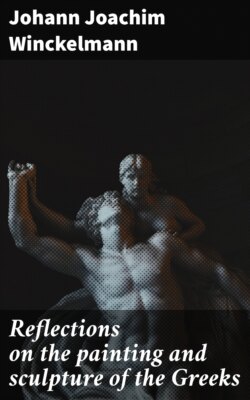Читать книгу Reflections on the painting and sculpture of the Greeks - Johann Joachim Winckelmann - Страница 10
На сайте Литреса книга снята с продажи.
VI. Painting.
ОглавлениеTable of Contents
Greek Painting perhaps would share all the praises bestowed on their Sculpture, had time and the barbarity of mankind allowed us to be decisive on that point.
All the Greek painters are allowed is Contour and Expression. Perspective, Composition, and Colouring, are denied them; a judgment founded on some bas-reliefs, and the new-discovered ancient (for we dare not say Greek) pictures, at and near Rome, in the subterranean vaults of the palaces of Mæcenas, Titus, Trajan, and the Antonini; of which but about thirty are preserved entire, some being only in Mosaic.
Turnbull, to his treatise on ancient painting, has subjoined a collection of the most known ancient pictures, drawn by Camillo Paderni, and engraved by Mynde; and these alone give some value to the magnificent and abused paper of his work. Two of them are copied from originals in the cabinet of the late Dr. Mead.
That Poussin much studied the pretended Aldrovandine Nuptials; that drawings are found done by Annibal Carracci, from the presumed Marcius Coriolanus; and that there is a most striking resemblance between the heads of Guido, and those on the Mosaic representing Jupiter carrying off Europa, are remarks long since made.
Indeed, if ancient Painting were to be judged by these, and such like remains of Fresco pictures, Contour and Expression might be wrested from it in the same manner. For the pictures, with figures as big as life, pulled off with the walls of the Herculanean theatre, afford but a very poor idea of the Contour and Expression of the ancient painters. Theseus, the conqueror of the Minotaur, worshipped by the Athenian youths; Flora with Hercules and a Faunus; the pretended judgment of the Decemvir Appius Claudius, are on the testimony of an artist who saw them, of a Contour as mean as faulty; and the heads want not only Expression, but those in the Claudius even Character.
But even this is an evident instance of the meanness of the artists: for the science of beautiful Proportions, of Contour, and Expression, could not be the exclusive privilege of Greek sculptors alone.
However, though I am for doing justice to the ancients, I have no intention to lessen the merit of the moderns.
In Perspective there is no comparison between them and the ancients, whom no earned defence can intitle to any superiority in that science. The laws of Composition and Ordonnance seem to have been but imperfectly known by the ancients: the reliefs of the times when the Greek arts were flourishing at Rome, are instances of this. The accounts of the ancient writers, and the remains of Painting are likewise, in point of Colouring, decisive in favour of the moderns.
There are several other objects of Paintings which, in modern times, have attained greater perfection: such are landscapes and cattle pieces. The ancients seem not to have been acquainted with the handsomer varieties of different animals in different climes, if we may conclude from the horse of M. Aurelius; the two horses in Monte Cavallo; the pretended Lysippean horses above the portal of St. Mark’s church at Venice; the Farnesian bull, and other animals of that groupe.
I observe, by the bye, that the ancients were careless of giving to their horses the diametrical motion of their legs; as we see in the horses at Venice, and the ancient coins: and in that they have been followed, nay even defended, by some ignorant moderns.
’Tis chiefly to oil-painting that our landscapes, and especially those of the Dutch, owe their beauties: by that their colours acquired more strength and liveliness; and even nature herself seems to have given them a thicker, moister atmosphere, as an advantage to this branch of the art.
These, and some other advantages over the ancients, deserve to be set forth with more solid arguments than we have hitherto had.
